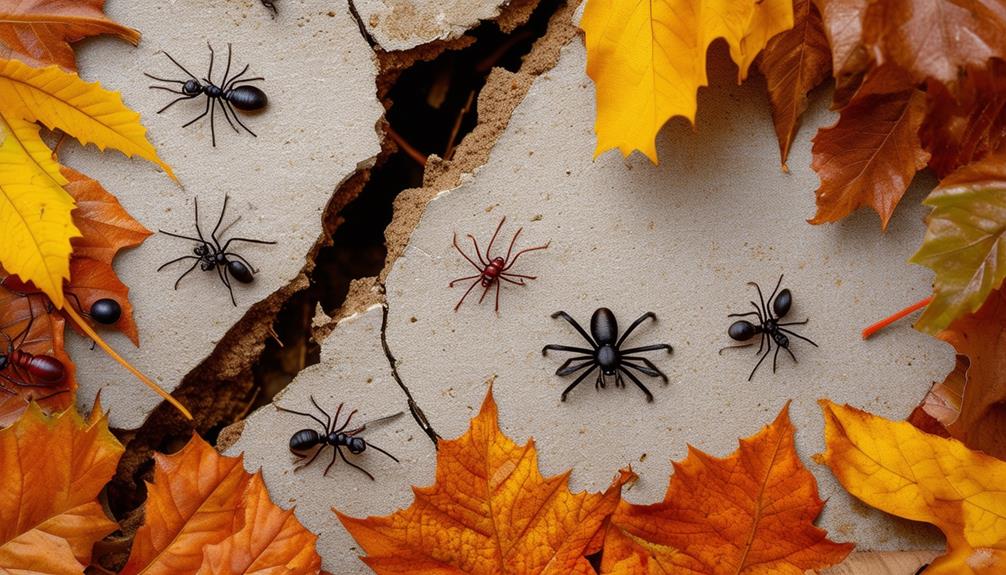In the realm of household pest control, the use of indoor pesticides is a common practice. Whether it’s to ward off pesky insects, eliminate rodents, or deter other unwanted creatures, these chemical substances are often employed to provide a sense of security and cleanliness within our living spaces.
However, the question of their safety arises, particularly after they have dried. While the notion of a dried pesticide may seem innocuous, it is crucial to delve deeper into the matter and understand the potential risks associated with their usage.
This article aims to explore the safety of indoor pesticides once they have dried, shedding light on the chemicals employed in these products and evaluating the potential risks of prolonged exposure. By providing an objective and informative analysis, this article aims to equip readers with the knowledge necessary to make informed decisions regarding the use of indoor pesticides.
Furthermore, it will also present alternative pest control methods that may serve as safer alternatives, promoting a holistic approach to maintaining a clean and pest-free environment.
Understanding the Chemicals Used in Indoor Pesticides
The intricate composition of chemicals found in indoor pesticides presents a complex interplay of elements akin to a delicate symphony, each playing its own role in the effectiveness and safety of the product.
Understanding pesticide regulations is crucial in comprehending the chemicals used in indoor pesticides. These regulations ensure that the pesticides available in the market undergo rigorous testing to determine their safety and efficacy. Regulatory bodies such as the Environmental Protection Agency (EPA) set standards and guidelines that manufacturers must adhere to in order to protect human health and the environment.
In addition to understanding pesticide regulations, it is important to consider the environmental impact of indoor pesticides. While these products are designed to eradicate pests and protect our homes, they can also have unintended consequences on the environment. Some pesticides, especially those that are persistent and have low water solubility, can accumulate in the soil and water, posing a threat to non-target organisms such as beneficial insects and aquatic life. Therefore, it is crucial to use indoor pesticides responsibly and according to the instructions provided by the manufacturer.
Transitioning into the subsequent section about evaluating the risks of exposure, it is essential to consider the potential effects of indoor pesticides on human health.
Evaluating the Risks of Exposure
Following label instructions is of utmost importance when using indoor pesticides, as it ensures the safe and proper use of these chemicals.
Failure to follow instructions can lead to potential health risks, especially when it comes to exposure to dried pesticides.
Understanding the potential health effects of exposure to dried pesticides is crucial in order to mitigate any potential harm and protect the well-being of individuals.
The importance of following label instructions
Properly adhering to the instructions on the label ensures that indoor pesticides are effectively applied and minimizes any potential risks.
Label accuracy is crucial in providing users with clear and concise information on how to safely and effectively apply the pesticide. It is important to carefully read and follow the label instructions, as they provide guidance on the appropriate dosage, application method, and safety precautions. By adhering to these instructions, users can ensure that the pesticide is applied in the correct concentration and manner, maximizing its effectiveness while minimizing any potential harm.
In addition to label accuracy, proper application of indoor pesticides is essential for ensuring safety. Following the recommended application method helps to ensure that the pesticide is evenly distributed and reaches the target pests effectively. This can involve techniques such as spraying, baiting, or dusting, depending on the type of pesticide and the target pest. Proper application also includes taking necessary precautions to protect oneself and others, such as wearing protective clothing, using appropriate equipment, and avoiding contact with treated surfaces. By following these instructions, users can minimize the risk of exposure to the pesticide and its potential health effects.
Transitioning into the subsequent section about the potential health effects of exposure to dried pesticides, it is important to understand the risks associated with improper handling or exposure.
Potential health effects of exposure to dried pesticides
Exposure to dried pesticides can have potential adverse health effects, ranging from respiratory irritation to neurological symptoms. It is important to understand that even after pesticides have dried, they can still pose a risk to human health and the environment.
Here are three potential long-term effects and environmental impacts of exposure to dried pesticides:
- Chronic Health Conditions: Prolonged exposure to dried pesticides has been linked to the development of chronic health conditions. Studies have shown that individuals regularly exposed to dried pesticides may experience an increased risk of respiratory problems such as asthma, bronchitis, and other respiratory irritations. Moreover, some pesticides contain chemicals that can affect the nervous system, leading to neurological symptoms such as headaches, dizziness, and even memory loss. These long-term health effects highlight the importance of taking precautions when using indoor pesticides.
- Environmental Contamination: Dried pesticides can also have a significant impact on the environment. When pesticides are applied indoors, they can accumulate in dust particles and settle on various surfaces. Over time, these residues can be released into the air or contaminate water sources, leading to the pollution of the surrounding environment. This contamination can have detrimental effects on wildlife, plants, and even human beings who come into contact with the contaminated areas.
- Resistance and Persistence: Another concern related to dried pesticides is the development of resistance in pests. When pesticides are used repeatedly, pests can develop resistance to their effects, making them more difficult to control. Additionally, some pesticides have a long persistence in the environment, meaning they can remain active for extended periods. This persistence can result in unintended exposure for individuals and wildlife, further increasing the potential for adverse health effects and environmental damage.
Understanding the potential long-term effects and environmental impact of exposure to dried pesticides emphasizes the need for safety precautions when using these substances. It is crucial to follow safety guidelines, use protective equipment, and consider alternative methods that are less harmful to human health and the environment. By taking these precautions, we can minimize the risks associated with indoor pesticide use and ensure a safer and healthier living environment.
Safety Precautions for Using Indoor Pesticides
To ensure the safe use of indoor pesticides, it is important to adhere to established guidelines and precautions. Proper handling is crucial to minimize potential hazards associated with these chemicals.
When using indoor pesticides, it is essential to carefully read and follow the instructions provided by the manufacturer. This includes wearing appropriate protective clothing, such as gloves and goggles, to prevent direct contact with the pesticide.
Additionally, it is important to ensure proper ventilation in the area where pesticides are being applied. Opening windows and using fans can help to dissipate any fumes or vapors that may be released during the application process.
Furthermore, it is advisable to keep children and pets away from treated areas until the pesticide has completely dried. This helps to reduce the risk of accidental ingestion or skin contact. It is also important to store pesticides in their original containers, tightly sealed, and out of reach of children or pets. Proper storage ensures that the pesticides remain effective and reduces the potential for accidental exposure.
Following proper handling procedures and taking necessary precautions is crucial for the safe use of indoor pesticides. These measures minimize the potential hazards associated with these chemicals. By adhering to guidelines and using indoor pesticides responsibly, individuals can effectively manage pests in their indoor spaces.
Transitioning into the subsequent section about ‘alternative pest control methods’, it is important to explore other options that may be safer and more environmentally friendly.
Alternative Pest Control Methods
One potential alternative to consider for pest control is the use of natural or organic methods, which may be more environmentally friendly and pose fewer health risks. Organic solutions can be effective in repelling pests without the use of harmful chemicals. These solutions often use natural ingredients such as essential oils, botanical extracts, or plant-based repellents. They are designed to target specific pests while being safe for humans and pets.
When it comes to natural repellents, there are several options to choose from. One option is the use of essential oils, such as peppermint oil or lavender oil, which can be applied to areas where pests are commonly found. These oils have strong scents that act as a deterrent for pests.
Another option is the use of botanical extracts, such as neem oil or pyrethrum, which are derived from plants and have insecticidal properties. These extracts can be used to create sprays or traps that effectively control pests. Additionally, plant-based repellents, such as garlic or onion sprays, can be used to repel insects from specific areas.
By utilizing organic solutions and natural repellents, individuals can effectively control pests while minimizing environmental impact and health risks. These alternatives provide a safer and more sustainable approach to pest control, addressing the subconscious desire to serve others by prioritizing the well-being of both humans and the environment.
Frequently Asked Questions
How long does it typically take for indoor pesticides to dry after application?
The drying time of indoor pesticides varies depending on the product used. It is important to follow the instructions provided by the manufacturer to ensure the effectiveness of the pesticide and to use it safely.
Can indoor pesticides be harmful to pets or children after they have dried?
Potential side effects of indoor pesticides on pets or children after they have dried include respiratory issues, skin irritation, and gastrointestinal problems. To ensure safety, recommended precautions include keeping pets and children away from treated areas and ventilating the space.
Is it safe to use indoor pesticides in areas where food is prepared or consumed?
Indoor pesticide residue should not come into contact with areas where food is prepared or consumed. Safe handling of indoor pesticides is crucial to prevent contamination and potential harm to human health.
Are there any specific health risks associated with long-term exposure to indoor pesticides?
Long-term exposure to indoor pesticides can pose health risks and safety concerns. Studies have shown potential links to respiratory problems, neurological disorders, and certain cancers. It is important to exercise caution and consider alternative pest control methods.
What are the potential environmental impacts of using indoor pesticides?
The use of indoor pesticides can have significant environmental consequences, including pollution of air, water, and soil. To mitigate these impacts, it is advisable to consider safe alternatives to minimize harm to the environment.





